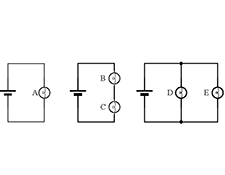
A model for circuits Part 1: Current and resistance
Variant i Dynamics first
Developed by Peter Shaffer (creator), Mark Somers (contributor), Greg Francis (contributor), Mackenzie Stetzer (contributor), and David Smith (contributor)
Students construct a model for simple dc circuits they can use to predict bulb brightness. The concepts of current, resistance, and series and parallel connections are introduced.
Topics Electricity and magnetism / Electric circuits: models, circuits, and current
Materials
Materials by the UW team
- Equipment List

- Instructor’s Guide


- Sample Pre-test


- Sample Exam Questions



Tutorial details
The tutorial leads students through a process of model building by making observations, introducing assumptions to account for their observations, and then testing and modifying the assumptions as needed. Students begin by exploring how to make a light bulb glow using only a battery and a single wire. They discover that it is necessary to form a complete path that connects both terminals of the battery and different parts of the bulb. Students then carefully examine a bulb to specify how a bulb should be connected to form a circuit. The idea that an electric current flows through a complete circuit is introduced and emphasized.
In sections II and III, students make observations of circuits containing two bulbs. Using the assumption that the brightness of a bulb indicates the amount of current through that bulb, students make inferences about the relative current through bulbs in series and parallel circuits
In particular, students recognize that adding a bulb in series to a circuit increases the resistance of the entire circuit and thus decreases the current through the battery, while adding a bulb in parallel decreases the resistance of the circuit and increases the current through the battery. In the last section of the tutorial, students investigate a slightly more complicated circuit that cannot be analyzed completely using a current model. This result motivates the voltage model for current, which is covered in the subsequent tutorial.
For instruction tips, login or register as a verified educator to see the Instructor Guide.
Prerequisites
This tutorial assumes no prior knowledge of electric circuits, current, or resistance.
Equipment
Special Instructions
All the bulbs used by a group of students should be identical.
At the start, each student should be given a kit containing a single wire, bulb, and battery.
List
- battery
- battery holders (2)
- D-cell
- white board or large sheet of paper with markers
- bulbs (large with glass broken so student can see how inside wires are connected)
- bulbs (#14) in sockets
- ample connecting wire including some alligator clips
Research
- L. McDermott and P. Shaffer, Research as a Guide for Curriculum Development: An Example from Introductory Electricity. Part I: Investigation of Student Understanding, Am. J. Phys. 60 (11), 994 (1992).
- P. Shaffer and L. McDermott, Research as a Guide for Curriculum Development: An Example from Introductory Electricity. Part II: Design of Instructional Strategies, Am. J. Phys. 60 (11), 1003 (1992).
- M. R. Stetzer, P. van Kampen, P. S. Shaffer, and L. C. McDermott, New insights into student understanding of complete circuits and the conservation of current, 81 (2) 134-143 (2013).
Coming Soon! We hope to release the discussion section on each tutorial by the end of July 2024.

